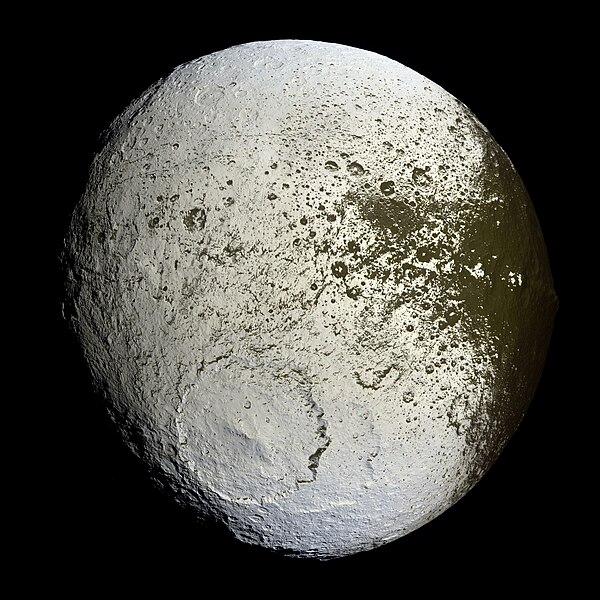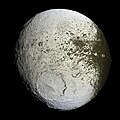קובץ:Iapetus as seen by the Cassini probe - 20071008.jpg

גודל התצוגה המקדימה הזאת: 600 × 600 פיקסלים. רזולוציות אחרות: 240 × 240 פיקסלים | 480 × 480 פיקסלים | 768 × 768 פיקסלים | 1,024 × 1,024 פיקסלים | 2,048 × 2,048 פיקסלים | 4,032 × 4,032 פיקסלים.
לקובץ המקורי (4,032 × 4,032 פיקסלים, גודל הקובץ: 6.22 מ"ב, סוג MIME: image/jpeg)
היסטוריית הקובץ
ניתן ללחוץ על תאריך/שעה כדי לראות את הקובץ כפי שנראה באותו זמן.
| תאריך/שעה | תמונה ממוזערת | ממדים | משתמש | הערה | |
|---|---|---|---|---|---|
| נוכחית | 21:07, 12 בדצמבר 2018 |  | 4,032 × 4,032 (6.22 מ"ב) | Kesäperuna | 100% JPEG quality from full quality TIFF, slightly cropped to be more centered. |
| 12:18, 9 באוקטובר 2007 |  | 4,100 × 4,100 (1.56 מ"ב) | Startaq | {{Information |Description = Cassini captures the first high-resolution glimpse of the bright trailing hemisphere of Saturn's moon Iapetus. This false-color mosaic shows the entire hemisphere of Iapetus (1,468 kilometers, or 912 miles across) visible fro |
שימוש בקובץ
הדפים הבאים משתמשים בקובץ הזה:
- יאפטוס (ירח)
- ויקיפדיה:תמונה מומלצת/הוספה למומלצים/ארכיון 14
- ויקיפדיה:תמונה מומלצת/המלצות קודמות/מאי 2010
- ויקיפדיה:תמונה מומלצת/המלצות קודמות/מאי 2013
- תבנית:תמונה מומלצת 15 במאי 2010
- תבנית:תמונה מומלצת 30 במאי 2013
- פורטל:מדעי החלל/היום בהיסטוריה/25 באוקטובר
- פורטל:מדעי החלל/היום בהיסטוריה/אוקטובר
- פורטל:מדעי החלל/תמונה נבחרת/61
- פורטל:מדעי החלל/תמונה נבחרת/גלריה
שימוש גלובלי בקובץ
אתרי הוויקי השונים הבאים משתמשים בקובץ זה:
- שימוש באתר af.wikipedia.org
- שימוש באתר an.wikipedia.org
- שימוש באתר ar.wikipedia.org
- שימוש באתר ary.wikipedia.org
- שימוש באתר arz.wikipedia.org
- שימוש באתר ast.wikipedia.org
- שימוש באתר az.wikipedia.org
- שימוש באתר ba.wikipedia.org
- שימוש באתר be.wikipedia.org
- שימוש באתר bg.wikipedia.org
- שימוש באתר bn.wikipedia.org
- שימוש באתר bn.wikibooks.org
- שימוש באתר bs.wikipedia.org
- שימוש באתר ca.wikipedia.org
- שימוש באתר ckb.wikipedia.org
- שימוש באתר cs.wikipedia.org
- שימוש באתר cv.wikipedia.org
- שימוש באתר cy.wikipedia.org
- שימוש באתר de.wikipedia.org




